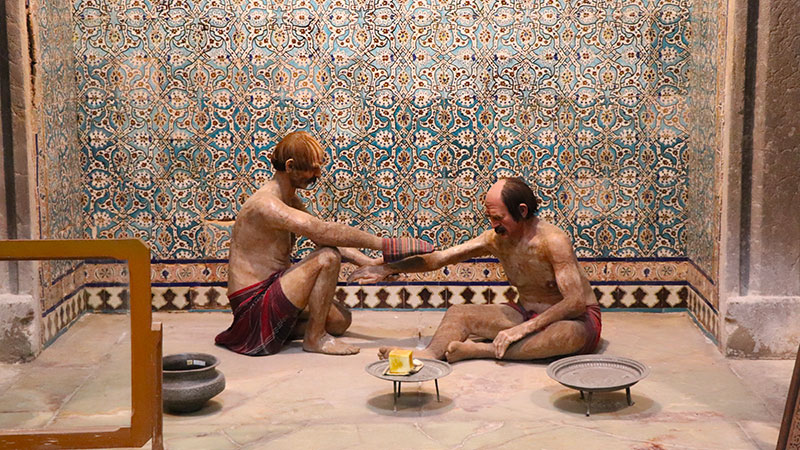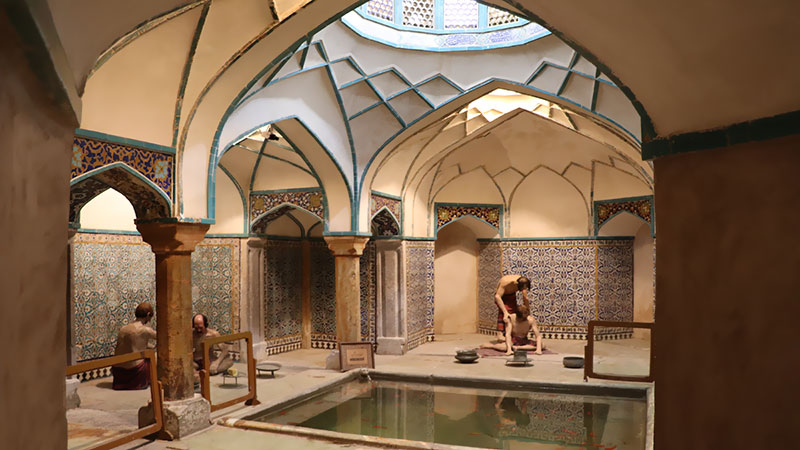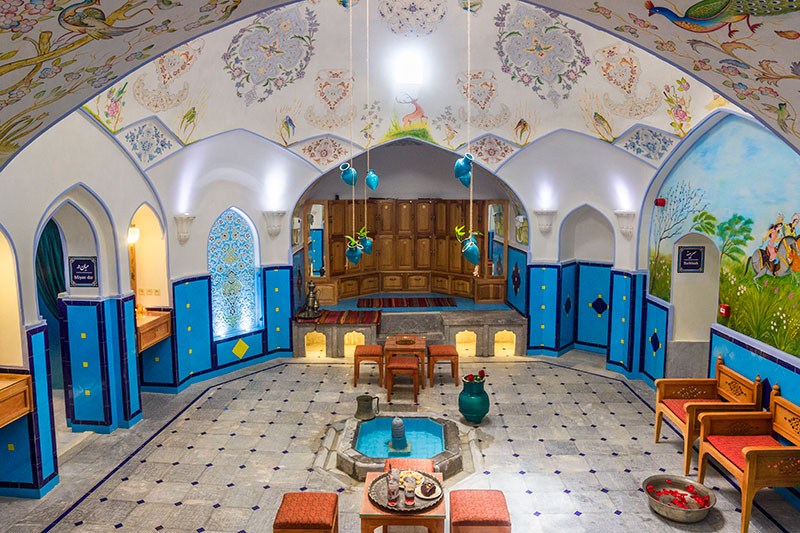 Signin with Google
Signin with Google Signin with Facebook
Signin with Facebook
 Culture,History
Culture,HistoryHammam, the Second Home to Ancient Iranians

If the Persian garden as a world heritage is a unique style of garden design, then the Persian bath along with its age-old rituals is an important brand of public hygiene in the history of the world.
Iranian traditional bathhouses have never been a place only for personal bathing; rather they have played the role of a social forum, a place for communication, relaxation and recreation. In the time when no TV news or social media existed people used to get the last news in the bathhouses one of the major places for staying up to date with the latest news, passing information and spreading rumours. Moreover, a Hammam was a location where many important social and political events took place and traditional rituals were performed, including Hana Bandan (bridal henna party), Hammam-e Zayeman (childbirth bath), mourning bath upon the loss of dear ones and etc.
The importance of bathing in Iranian culture dates back to the pre-Islamic era. According to Persian mythology, the first bathhouses were constructed in the time of Jamshid Shah, and according to archaeological documents, the earliest ruins of bathhouses were found in Chogha Zanbil, an ancient Elamite complex and UNESCO world heritage in Khouzestan province.

The Influence of Religion on Development of Bathhouses
Although cleanliness and hygiene were already important in pre-Islamic Iran where the state religion was Zoroastrianism, the conversion to Islam attached more importance to it to the extent that it was considered to be half of a Muslim’s faith. In the Islamic period in Iran, especially in the Safavid era, as reported by Jean Chardin in his book The Travels of Sir John Chardin there were more than 270 public bathhouses only in Isfahan during the Safavid era which not only shows the significance of sanitation but also the high level of urban development of Iran in that era.
The Traditional Spa and Wellness Centre
As previously mentioned, bathhouses were used for several purposes other than bathing. A bathhouse (or Hammam as said in Persian) was one of the major places people –specifically women- often frequented for relaxation activities like getting a massage or beautifying deeds such as having a haircut, clipping their nails and face makeup in addition to shaving.
Furthermore, Hammams were also used as wellness centres for doing traditional medical treatments like massage, bloodletting, cupping and circumcision.

Various types of Iranian bathhouses
Depending on the location and application, bathhouses were divided into two main categories:
Private Bathhouses: These kinds of bathhouses only belonged to the kings categorized into two groups including Hammams located in the palaces or in residences of the officials where kings and their families exclusively used and the other group of private baths which is hammams in the houses of royals. In the Qajar era, noble families had their private baths in their residences and it was a way to declare their social status clearly.

Public Bathhouses: These Types of Hammams were built for public use and ordinary people. Depending on their use there could be different kinds of public bathhouses in a city, and some of them can be categorized as follows:
- Bazaar Bathhouses: These bathhouses were usually located in the city centre and were a part of a bigger complex consisting of a mosque, a bazaar and sometimes a religious school and they were used by citizens and locals but mostly they were men-only bathhouses. The working hours of these Hammams were usually divided into two shifts, one for men from dawn (around 4:00 am) to the morning (around 9 am) and the other for women starting around 10 in the morning till the afternoon, however in more populous cities there were separated bathhouses for both male and females which were available full time.
- City Gate Bathhouses: These types of public bathhouses were often found in cities that were frequently visited by foreigners such as merchants, tourists and students and they were usually located near the city gate to provide a washing and cleaning spot for the visitors of the city before entering it.
- Caravanserai Bathhouses: Caravanserais were roadside establishments built to accommodate travellers on their long trips. Along with other convenience facilities, they usually had bathhouses to provide guests with an appropriate place to wash and clean themselves. The water used in the caravanserai bathhouse was supplied by Qanat an underground tunnel that leads the water from the heights to the surface of the ground sustainably.
- Hot Spring Bathhouses: Because of its health benefits, the surrounding of a natural hot spring had been used as a place for bathing, especially in the Qajar period.

Based on the bath construction of the public bathhouses there are four main groups of public bathhouses containing
- Individual Public Bathhouses feature separated times for men and women during the day.
- Twin Public Bathhouses offer separated spaces to be used by different genders parallel at the same time.
- Triple Bathhouses used to have a particular building as well as separate bathhouses for women and men for religious minorities. There is only one example of this group that remained in Arak city which is the 'Four Season' hammam.
- Communal Shower Baths which was followed after lacking hygiene in public baths that caused infectious diseases during the and Pahlavi period
The Unique Architecture of Persian Traditional Bathhouses
Like any other indigenous historical building which is constructed based on traditional Iranian architecture style, bathhouses were designed and built in accordance with the natural and cultural context of their environment, considering sustainable architecture principles such as energy efficiency and using local-natural resources, in this regard bathhouses were usually built underground with the roof at ground level or lower in order to ease the process of directing the water current, keep the environment of it warm in the winter and moderate it in the summer.
To make the floor of the bathhouse warm, plumbing was constructed between the cold, dry and warm parts of a hot room.
And on top of that what makes these structures architecturally unique is their ornamentation details such as colourful tile works, archways and vaulted walls and scenes from Shahnameh, usually painted in large scales on the walls or entrances.

Beyond the Shower and the Bathtub
According to traditional Iranian medicine and Islamic rules to prevent illness occurring after bathing it is necessary to go from cooler space to the warm and then hot room gradually. Traditional Persian bathhouse was much more than a shower and a bathtub, they were usually made of four main rooms with different spaces, including:
- Sardkhaneh/Bineh or Sarbineh (Cold Room): The first room which was cold and dry had an octagonal shape, a dome roof and is furnished with benches and carpets containing cubicle space used as a changing room.
- Mian Dar: The second room is cold and wet and functioned as the connection between Bineh and Garmkhaneh (the warm room). This space had a maze form to help keep Garmkhaneh warm and prevent the heat and energy from being wasted.
- Garmkhaneh (Warm Room): The third room is warm and wet and the bathing took place here.
- Khazineh: A large cold or hot water tank located in Garmkhaneh similar to today Jacuzzi pools
The Bathhouse Staff
The variety of spaces and tasks in a bathhouse requires a team to take care of them, some of the most famous jobs associated with traditional bathhouses in Iran are Oussa/Ostad (the bathhouse manager), Hammami (the bathhouse keeper/receptionist), Jamedar (the wardrobe keeper) and Dallak or Kise-kesh (the masseur/masseuse who uses peeling glove (kiseh) and chalk-like material (Sefid-ab) to scrub and exfoliate a client's body).

Famous Traditional Bathhouses Which Turned into Museums
Since the emergence of modern architecture which provided every house with a private bath, unfortunately, many of the traditional bathhouses were deserted and consequently demolished or transformed, however, a number of those great old bathhouses of Iran were preserved and now have been turned into museums or teahouses, some of the most famous ones are:
- Bab-e Homayoon Hammam in Tehran (exclusive hammam of Naser al-Din Shah Qajar)
- Sultan Mir Ahmad bathhouse in Kashan
- Ganjali Khan Hammam in Kerman
- Fin garden Hammam in Kashan (the venue of the murder Amir Kabir, Naser Al-Din Shah’s chief minister in 1852)
- Vakil Hammam in Shiraz
- Khan Hammam in Yazd
- ChaharFasl/ four-season Hammam in Arak
- Qajar Hammam in Qazvin
By Nazanin Moayed / TasteIran

